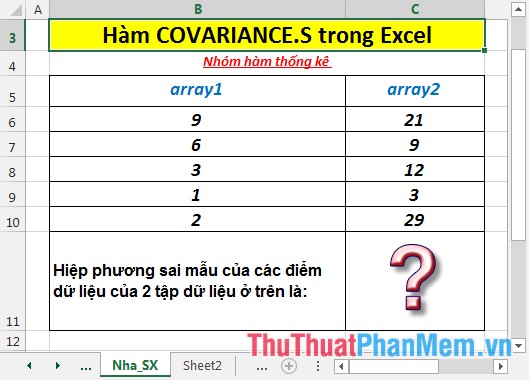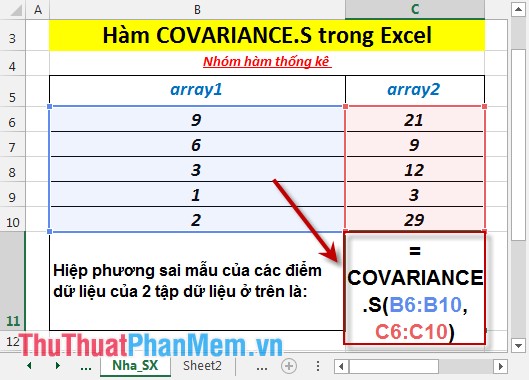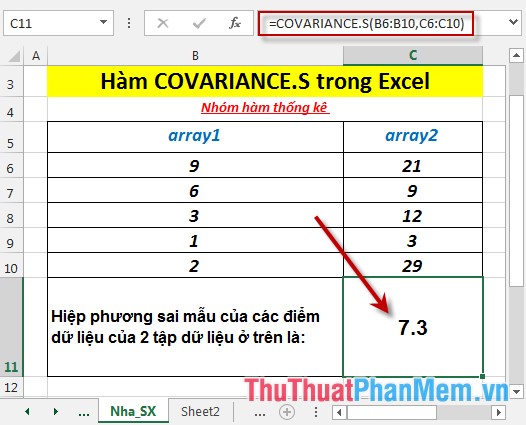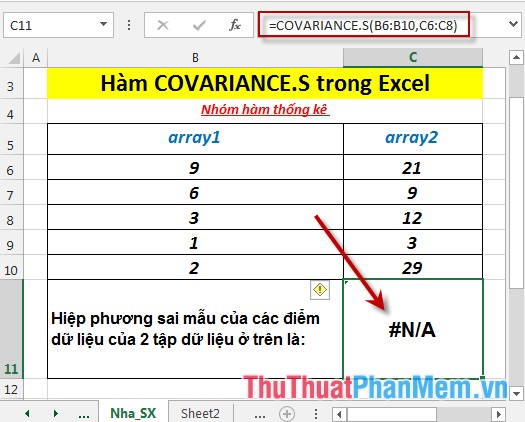COVARIANCE.S function - Returns the covariance pattern, the average of product deviations for each pair of data points in two data sets in Excel
The following article introduces you to the COVARIANCE.S function - one of the functions in the statistical function group is very popular in Excel.

Description: Returns the sample covariance, the product of the deviations for each pair of data points in the two data sets
Syntax: COVARIANCE.S (array1, array2)
Inside:
- array1: The first range contains integers that want to calculate the variance, is a required parameter.
- array2: The second range contains the integers that want to calculate the variance, is a required parameter.
Attention:
- The argument must be either a number or a reference array that contains numbers.
- If the reference argument or array contains text or logical values or empty cells will be ignored.
- If array1 and array2 have different data points -> the function returns the # N / A error value
- If 1 of the 2 arrays is empty -> the function returns the # DIV / 0 error value
For example:
Calculate the sample covariance, the average of the product of deviations of each data point pair of the two data sets in the following table:

- In the cell to calculate enter the formula : = COVARIANCE.S (B6: B10, C6: C10)

- Press Enter -> covariance sample, the average of the product of deviations of each data point pair of two data sets is:

- Where the number of pairs of points of 2 arrays is not the same -> the function returns the # N / A error value

Here array2 only contains 3 values from C6: C8
Above are instructions and some specific examples when using the COVARIANCE.S function in Excel.
Good luck!
You should read it
- DEVSQ function - The function returns the sum of squares of deviations of data points from the sample mean in Excel
- AVEDEV function - The function returns the average absolute deviation of data points from their midpoint in Excel
- GEOMEAN function - The function returns the average of a positive array or range of data in Excel
- TRIMMEAN function - The function returns the average of the inner part of a dataset in Excel
- F.DIST.RT function - The function returns the right probability distribution F for 2 data sets in Excel
- CORREL function - The function returns the correlation coefficient between two data sets in Excel
- PEARSON function - The function returns the Pearson product moment correlation coefficient in Excel
- HARMEAN function - The function returns the harmonic average of a data set in Excel
May be interested
- STDEVP function - The function of calculating standard deviations in Excel
 the following article details how to use the stdevp function in excel, which helps you calculate standard deviations based on patterns.
the following article details how to use the stdevp function in excel, which helps you calculate standard deviations based on patterns. - T.DIST.2T - The function returns the two-tailed Student distribution in Excel
 t.dist.2t: the function returns the two-tailed student's t-distribution. functions used in testing the hypothesis of small numbers of data sets. support functions from excel 2010 onwards. syntax: t.dist.2t (x, deg_freedom)
t.dist.2t: the function returns the two-tailed student's t-distribution. functions used in testing the hypothesis of small numbers of data sets. support functions from excel 2010 onwards. syntax: t.dist.2t (x, deg_freedom) - How to use the kernel function (PRODUCT function) in Excel
 in excel, product helps users to calculate product values, multiply arguments together, and return their results correctly.
in excel, product helps users to calculate product values, multiply arguments together, and return their results correctly. - How to use the NORMDIST function in Excel - Function that returns the distribution in Excel
 the normdist function returns a distribution with a specified mean and standard deviation. the normdist function has applications in statistics, including hypothesis testing.
the normdist function returns a distribution with a specified mean and standard deviation. the normdist function has applications in statistics, including hypothesis testing. - PRODUCT function in Excel, syntax, usage
 the product function in excel helps to quickly calculate the product of multiple values, instead of having to enter each number with a multiplication sign. this function is useful in calculating financial, scientific and accounting data.
the product function in excel helps to quickly calculate the product of multiple values, instead of having to enter each number with a multiplication sign. this function is useful in calculating financial, scientific and accounting data. - Multiplication function (PRODUCT function) in Excel
 the multiplication function in excel is very important for those who often have to process and calculate data in excel. in excel you can also use the * operator to multiply data, but with large amounts of data you should use the multiplication function - product to get
the multiplication function in excel is very important for those who often have to process and calculate data in excel. in excel you can also use the * operator to multiply data, but with large amounts of data you should use the multiplication function - product to get - HYPGEOM.DIST - The function returns the hyperbolic distribution in Excel
 hypgeom.dist: the function returns the hyperinfection distribution, using this function for problems with finite sets of vowismooix observations whether or not they are successful. syntax: hypgeom.dist (sample_s, number_sample, population_s, number_pop, cumulative)
hypgeom.dist: the function returns the hyperinfection distribution, using this function for problems with finite sets of vowismooix observations whether or not they are successful. syntax: hypgeom.dist (sample_s, number_sample, population_s, number_pop, cumulative) - How to use the WRAPROWS function in Excel
 having trouble with handling large data sets in excel? then learn how to use the wraprows function to split them into more manageable rows.
having trouble with handling large data sets in excel? then learn how to use the wraprows function to split them into more manageable rows. - TRIMMEAN function - The function returns the average of the inner part of a dataset in Excel
 trimmean function: the function returns the average of the inside of the data set. the function calculates by removing which percentage of the value is in the first or last boundary of the data set. syntax: trimmean (array, percent)
trimmean function: the function returns the average of the inside of the data set. the function calculates by removing which percentage of the value is in the first or last boundary of the data set. syntax: trimmean (array, percent) - QUARTILE.EXC function - The function returns the quartile of a dataset without values 0 and 1 in Excel
 quartile.exc function: the function returns the quartile of the data set, with percentile values from 0 to 1 excluding 0 and 1. the support function is from excel 2010 onwards. syntax: quartile.exc (array, quart)
quartile.exc function: the function returns the quartile of the data set, with percentile values from 0 to 1 excluding 0 and 1. the support function is from excel 2010 onwards. syntax: quartile.exc (array, quart)










 INTERCEPT function - The function returns the point at which the line will intersect the y-axis by using the existing x and y values in Excel
INTERCEPT function - The function returns the point at which the line will intersect the y-axis by using the existing x and y values in Excel MODE.SNGL function - Function that returns the most frequently occurring, or the most repeated values in an array or data range in Excel
MODE.SNGL function - Function that returns the most frequently occurring, or the most repeated values in an array or data range in Excel NORM.S.INV function - The function returns the inverse of the normalized distribution with an average value of 0 and a standard deviation of 1 in Excel
NORM.S.INV function - The function returns the inverse of the normalized distribution with an average value of 0 and a standard deviation of 1 in Excel PERCENTRANK.EXC function - The function returns the rank of a value in a dataset as a percentage excluding values 0 and 1 in Excel
PERCENTRANK.EXC function - The function returns the rank of a value in a dataset as a percentage excluding values 0 and 1 in Excel PERCENTRANK.INC function - The function returns the rank of a value in a dataset as a percentage including values 0 and 1 in Excel
PERCENTRANK.INC function - The function returns the rank of a value in a dataset as a percentage including values 0 and 1 in Excel PROB function - The function returns the probability that values in a range are between two limits in Excel
PROB function - The function returns the probability that values in a range are between two limits in Excel